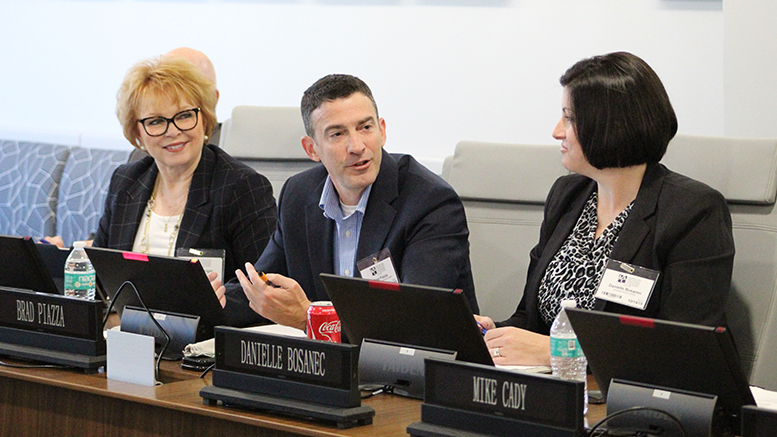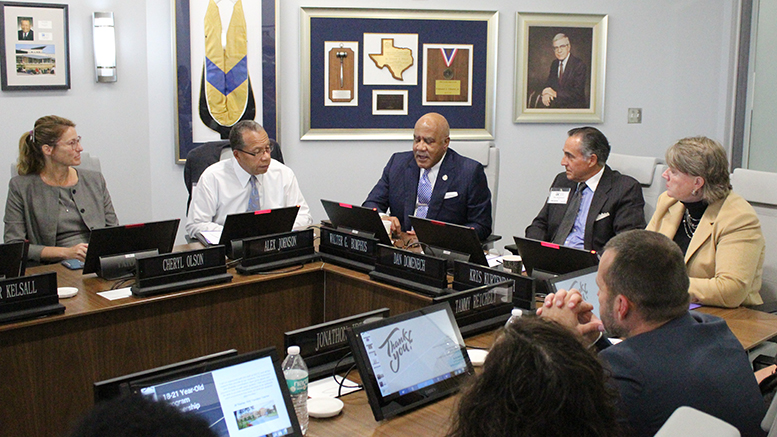At the first national convening of community college presidents and K-12 superintendents in 2014, improving college readiness was the focus of the discussions.
Since then, members of the American Association of Community Colleges (AACC) and AASA, The Superintendents Association have gathered periodically in Washington, D.C., to share promising practices and emerging challenges. They’ve discussed a range of topics, from dual enrollment and broadband access, to federal policy regarding Pell grants and funding sources. And they’ve looked at those issues from the lenses of urban and rural schools.
At the groups’ meeting this week, the leaders reflected on how the bonds between K-12 schools and community colleges have grown as a result of the collaboration. Following a presentation by leaders from Waukesha County Technical College and Pewaukee School District (Wisconsin) about their partnership — which includes a program to serve adults with disabilities ages 18 to 21 — AACC President Walter Bumphus and AASA Executive Director Dan Domenech noted how much the “K-14” partnership had developed beyond just discussions about dual enrollment.
“It’s really turning the culture and value of education around,” Domenech said. “It’s happening because of this combined effort.”
“This is what we envisioned,” added Bumphus, noting that the dialogue stemmed from recommendations proposed by AACC’s 21st-Century Commission on the Future of Community College.
Overcoming the CTE stigma
Although many K-12 schools and community colleges have developed stronger ties to ensure students are prepared for college and the workforce, convincing families about the value of career and technical education (CTE) remains a challenge in some areas. In others, particularly rural areas, families remain skeptical about the need for any postsecondary education.
Families see the importance of CTE — just not for their kids, who are expected to go to a four-year college, Domenech said.
“We need to honor the plumbers as we do the Ph.Ds,” he said.
That’s an issue Danielle Bosanec, chief academic officer at Pewaukee School District, sees regularly. More than 90 percent of her district’s high school graduates leave to attend a four-year college, but a significant number of them return and then opt to go to a local college, she said.
But partnerships like the one her district developed with Waukesha County Technical College (WCTC) is helping to change perceptions. It has developed a “graduate profile” that includes six competencies students must have, as well as indicators for each competency. For example, to help students foster skills necessary to “Connect” (one of the six competencies), all high school seniors will have a mentor in a career area that interests them. For the “Compete” competency, each graduate will earn some college credit or an industry certification.
“We’re changing what their experience is going to be when they leave us,” she said.
Working together
Finding mentors and ensuring students attain a credential or college credits requires partnerships, Bosanec noted. Some 3,300 high school students took courses with WCTC in 2017-18 through partnership agreements.
The partnership also has developed a Dual Enrollment Academy that focuses on six areas, such as firefighter-EMT and building construction, which address the in-demand needs of local employers, said Brad Piazza, vice president of learning at WCTC.

Brad Piazza of Waukesha County Technical College and Danielle Bosanec (right) of the Pewaukee School District outline programs resulting from their partnership.
The college has other unique programs with the district, such as its Elements of Health & Medicine program. Participating high school students can take courses such as Medical Interventions and Exercise Physiology & Sports Medicine that count toward their diploma, and they can earn college credit for taking the Nursing Assistant Program at WCTC. The program also includes a clinical rotation with a participating health care provider.
“The relationship between secondary and postsecondary education has endless opportunities,” Piazza said.
One of the challenges of the partnership has been managing the growth, especially among the academies, which employers have embraced, Piazza said. He noted one participating student completed an associate degree before earning her high school diploma, at no cost to her. Affordability is a message he wants to leverage.
AACC’s Bumphus said college costs will prompt many families who might not initially consider a community college or CTE path to take a closer look.
“Affordability is becoming even more important around the country,” he said.

